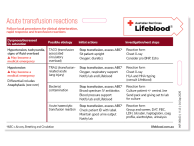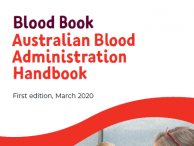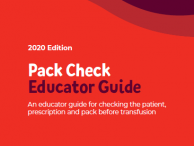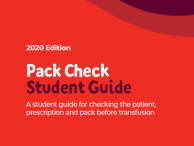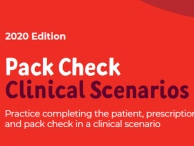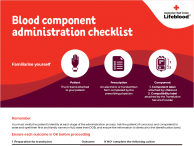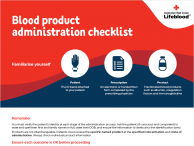Don’t have an account?
Select the donation type you’d like to make
Transfusion of blood components should only be undertaken where appropriate staff and facilities are available to identify and manage any potential adverse transfusion reactions.
All transfusions should be planned to take place during business hours, whenever possible, for patient safety.
Overnight or out of hours transfusions should be avoided unless clinically indicated by the patient’s condition.
The following is only a guide for administration of blood components as individual hospital guidelines should be followed.
- Pretransfusion preparation essentials
Ensure the following are in place before any transfusion:
- Staff and equipment are available and transfusion is occurring in a safe clinical area.
- Resuscitation equipment is checked, available and in working order, and that emergency medical support is readily available.
- All transfusion equipment is:
- approved for its intended use in blood component transfusion
- in date and has been checked, and
- used following the manufacturer’s recommendations and specifications for use, and used in keeping with local health service policy.
- Informed consent discussion has occurred and has been documented.
- All blood transfusions must have a valid informed consent. It can be provided by the patient, parent or legal guardian, or follow the emergency medical procedure consent protocols. A dialogue about the reasons for the transfusion and expectations of clinical outcomes must take place between the clinician and the patient or guardian. Any information provided should be in line with the patient or guardian’s literacy level and in a way they can understand. Consent must be documented in the patient’s medical record and/or on a transfusion-specific consent form in accordance with local health service policy. Refer to your local health service policy regarding consent processes for blood transfusion, including inability to obtain consent and for patients who refuse. All elements of the consent process should be aligned to local, State or territory and national requirements.
- Prescription is complete and valid.
- The treating physician is responsible for completing the prescription and documenting any special requirements. If the prescription is incomplete, obtain this from the prescribing physician.
- IV access is patent and appropriate to use.
- If uncertain, consult with your senior nurse or medical officer.
- Correct patient ID band is attached to the patient.
- Ask the patient (if conscious and competent) to state and spell their first and family names in full, state their date of birth (DOB), and ensure the information is identical on the identification band.
- The patient understands the procedure and possible adverse events.
- The person administering the component should ensure the patient understands the transfusion procedure, including symptoms of possible transfusion reactions.
- Record baseline observations.
- Within the 60 minutes before commencement of each pack, record patient temperature, pulse, respirations, blood pressure and general patient status including any pre-existing rashes.
- Administer premedication if ordered.
- If any pre-medication has been ordered, ensure it has been administered at the appropriate time prior to commencing transfusion.
Equipment
- Blood administration sets
- Blood components must be transfused using an administration set approved for this purpose. The set must incorporate a filter (170 to 200 µm) which removes large clots and aggregates and ensures an effective transfusion flow rate.
- Change the blood administration set when the transfusion is completed, or every 12 hours if continuing to transfuse or with new IV fluids or in accordance with the manufacturer’s instructions,
- One blood administration set may be used for multiple packs of red cells provided flow rate remains adequate and manufacturer's recommendations are not exceeded.
- Platelets must be transfused through a new blood administration set. In the setting of massive/rapid transfusion when platelets and plasma are both required, they may be transfused sequentially through the same blood administration set.
- Platelets must not be transfused through a blood administration set which has previously been used for red cells, as red cell debris in the in-line filter may trap infused platelets.
- Red cells may follow platelets through the same blood administration set, but not precede platelets.
- Bedside leucocyte filters are not required in Australia as platelets and red cells are leucocyte depleted by Lifeblood. There is no evidence that microaggregate filters offer clinical benefit and so their use is not recommended.
- Infusion devices and blood warmers
- Blood components may rapidly be infused or warmed just prior to or during transfusion if clinically indicated. Only approved blood devices should be used.
- All equipment used to administer blood components including volumetric infusion and external pressure or rapid infusion devices, syringe drivers and blood warmers, must be operated according to the manufacturer’s instructions and be designated safe and appropriate for blood transfusion.
- Equipment must undergo constant monitoring, calibration and maintenance.
- Local health service policy should indicate whether volumetric infusion and external pressure or rapid infusion devices and blood warmers can be used, including in which situations they are appropriate. Devices must be validated by the manufacturer for the administration of blood products and used exactly as specified by the manufacturer.
- Compatible fluids
- The blood administration set may be primed with the blood component or 0.9% sodium chloride.
- Do not add medication to the pack, blood administration set or IV line, or infuse solutions other than 0.9% sodium chloride through the same tubing along with blood components. ABO-compatible plasma, 4% albumin or other suitable plasma expanders may be used only if approved by the patient’s physician.
- Electrolyte solutions containing calcium, such as Haemaccel®, Hartmann's solution, lactated Ringer's solution must never be added to, or administered through, the same IV line as blood components containing citrated anticoagulant.
- Priming or flushing blood administration sets with a small amount of 0.9% sodium chloride between red cell packs is not evidence-based and may be unnecessary. However, 0.9% sodium chloride may be required to maintain IV access if the next red cell unit is not readily available.
Pre-administration check of the patient, prescription and pack
The final administration check is a vital step of the transfusion process and the last chance to ensure the right component is transfused to the right patient.
Each individual undertaking the administration of blood components should have an understanding of their roles and responsibilities.
Two staff members must independently perform uninterrupted checks at the patient’s side immediately prior to transfusion.
If there is any interruption or a delay, the checking process must be repeated.
Prior to administration, both clinicians must compare, confirm and be individually satisfied that this is the right pack for the right patient.
One of the two people involved in the checking process must spike and hang the blood component immediately after checking.
Required checks
- Patient identification
Where possible, involve the patient in the identification checks by asking them to state and spell their first and family names in full, state their DOB, ensure the information is identical on the identification band.
If the patient is not able to participate, ask a parent, guardian or carer to verify the patient’s identity.
If the patient’s identity cannot be confirmed, follow local health service policy.
For the purpose of checking identity, sometimes neonates are known as ‘baby of’ until they have been given a legal name. In the event that the neonatal patient’s identification details change, a new identification band must be attached to the patient.
- Pack integrity
Ensure the pack and component is suitable for transfusion:
- within expiry date and time
- no visible leaks at ports and seams
- no evidence of haemolysis, unusual discolouration or cloudiness, and
- no visible clots.
- Patient and compatibility label
Make sure the patient’s identification band details are identical to information on the compatibility label attached to the pack. These include:
- patient first and family name
- patient DOB, and
- patient medical record number.
- Compatibility and component labels
Compare the compatibility label attached to pack with the component label attached to the pack:
- donor identification numbers are identical, and
- ABO blood group is compatible.
- Patient and prescription
Compare all patient identifiers and ensure they are identical on identification band and prescription, including:
- patient first and family name
- patient DOB, and
- patient medical record number.
- Prescription and pack labels
Compare all patient identifiers and ensure they are identical on prescription and compatibility label including:
- patient first and family name
- patient DOB, and
- patient medical record number.
Compare blood component type and ensure it is the same as that on prescription.
Ensure that any special requirements have been met.
- Administration of blood components
- Frequent visual observation of the patient before, during and after the transfusion, is essential to identify possible adverse reactions.
- If an adverse transfusion reaction occurs, stop the transfusion immediately and initiate appropriate therapy. The transfusion should not restart unless the patient receives a satisfactory clinical review.
- Only one type of blood component should be administered at a time. Administering two different types of blood components concurrently (such as platelets and plasma) is not recommended in routine practice because in the event of an adverse reaction it is difficult to ascertain which component was responsible. This may be unavoidable in an emergency situation.
- Start the transfusion as soon as possible after removing the blood component from approved temperature-controlled storage. Transfusion of each pack should be completed prior to the labelled expiry or within four hours, whichever is sooner.
- The infusion should start slowly where clinically appropriate. The patient should be closely observed for the initial 15 minutes of the infusion as life-threatening reactions may occur after infusion of only a small volume. After 15 minutes the rate of infusion may be increased to the maximum prescribed rate, provided there are no signs or symptoms of an adverse reaction.
- Transfusion of each unit may proceed as fast as prescribed and tolerated. The infusion rate for blood components depends on the clinical context, age and cardiac status of the patient. In stable, non-bleeding adult patients, typical administrations durations are:
- Red cells 1-3 hours
- Platelets 15-30 minutes
- Fresh frozen plasma 30 minutes
- Cryoprecipitate 30-60 minutes per standard adult dose
- After completion of the transfusion, blood administration sets may be flushed with 0.9% sodium chloride to ensure that the patient receives all of the blood component. Only the minimum volume of 0.9% sodium chloride required to completely clear the IV line should be used, taking into consideration the individual circumstances of the patient (for example neonates, some paediatric patients or patients at risk of fluid overload or on fluid restrictions).
For more details on specific aspects of blood component administration, consult the Guidelines for the Administration of Blood Components.
